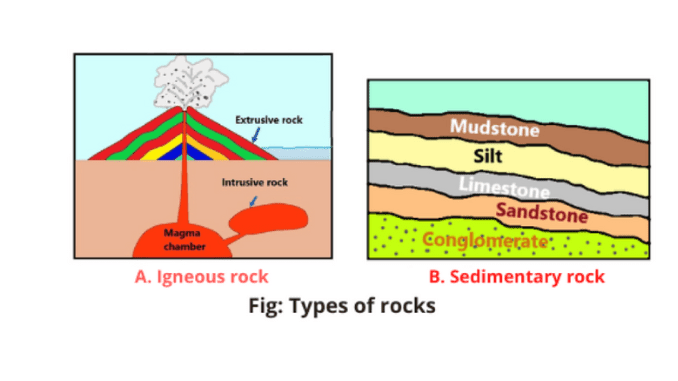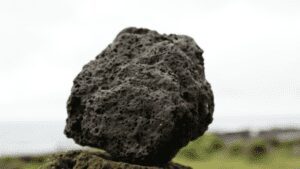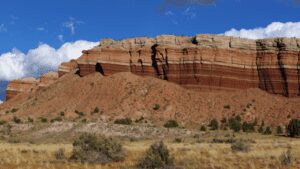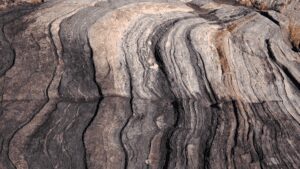
Introduction
The materials of the crust or lithosphere are known as rocks. Rock is a combination of naturally occurring solids or minerals. The rocks are classified based on different types of mineral composition and the formation method. Below is a discussion of rocks and their types.
The crust is the outer part of the rock. The depth of the crust is not the same everywhere, its average depth inside the continent is about 40-50 km and inside the ocean is about 5-10 km.
According to geologists, rocks are formed by the combination of two or more minerals. Rocks are formed naturally. But each type of rock has unique properties. There are mainly three types of rocks. These are igneous rock, sedimentary rock, and metamorphic rock. The characteristics of rocks and their classification are discussed in detail here (1) & (3).
Rock
The crust is made up of rocks which are again composed of different types of minerals. These minerals are mainly composed of crystalline solids which are formed as a result of the regular arrangement of chemical compounds. Minerals that form rocks are joined together by chemical bonds. The type and presence of minerals in the rock indicate where and how the rock was formed.
Some rocks may be composed of a single mineral. In this case, minerals and rocks are the same substance. For example, Calcite is a mineral and limestone. Rocks that are composed of more than one mineral are called heterogeneous rocks and rocks that are made of a single mineral are called homogeneous rocks. The major minerals that makeup rock are feldspar, olivine, pyroxene, calcite, dolomite, quartz, clay, gypsum, etc. (1)
Definition
Rocks are either composed of a single mineral or a mixture of several minerals that make up an essential part of the earth. It is a homogeneous or heterogeneous mixture of one or more minerals found in nature (2).
Characteristics
- Rocks are the hard materials that cover the earth’s crust.
- Pebbles rocks, soil, gravel sand, etc. also belong to the rock.
- Rock permeability is the ability of a liquid or gaseous substance to enter through a rock. Water holding capacity is high if the permeability is high.
- The porosity of the rock decreases or increases when the ratio of the space between the rocks to the volume is less. If the porosity is high, the water holding capacity increases (1) & (3).
Types of rocks
All rocks are not the same. Some rocks are fragile, some are strong and corrosive, some are layered, and some are massive. According to the method of origin, rocks are divided into three main categories. These are as follows.
1. Igneous rock

Meaning
The word igneous has been derived from the Latin word ‘ignis’ meaning thereby fire. It does not mean that the origin of igneous rock is associated with fire in any way (1).
Definition
At the time of creation, the earth was in a heated liquid state. Gradual heat radiation cools the earth’s surface and interior of the earth. Then various elements of the earth’s crust and the interior of the earth also cool and solidify to form a solid rock layer. This rock is called igneous rock.
This rock is called igneous rock because it is formed by the solidification of heated elements or magma. Igneous rock was first formed on the surface of the earth and this rock did not originate from any other rock, so it is called primary rock or primitive rock (1).
Example
Examples of igneous rocks are basalt, granite, dolerite, rhyolite, gabbro, etc.
Characteristics
The main features of igneous rocks are
- Igneous rock has no layers, so it is called unstratified rock.
- The presence of fossils in igneous rock is not noticeable.
- Igneous rocks are hard, impermeable in nature, and do not erode easily.
- Silica minerals are usually predominant in igneous rocks.
- Its density is very high.
- These types of rocks are usually crystalline or glass-shaped.
- Its corrosion resistance power is high.
- These rocks are relatively heavier than sedimentary and metamorphic rocks (2) & (4).
Types
According to the origin, igneous rocks are divided into two categories.
a. Extrusive or volcanic rock
During an eruption or through a crack, magma rises to the earth’s surface and flows as lava. When this lava comes in contact with a cold area, it quickly solidifies and turns into solid rock. Such rocks are called extrusive igneous rocks. The grains of this rock is very fine and the color is very dark.
Example:
Basalt rock is an igneous rock. It can be seen along the tram or train line. The hills of the Rajmahal in west Bengal are made of basalt.
Classification
Based on the origin, extrusive rocks can be divided into two categories.
- Lava rock
The rock that is formed when the lava of the volcano cools and solidifies is called lava rock. Most of the extrusive rocks are lava rocks. Basalt is lava rock.
- Pyroclastic rock
During a volcanic eruption, lava that has already accumulated in the mouth of a volcano or magma channel breaks out into ash, cinder, and small fragments, then they are called pyroclastic rocks. Volcanic tuff is a pyroclastic rock.
b. Intrusive rock
The hot molten material or magma of the earth’s core often does not reach the earth’s surface and gradually cools inside the interior part of the earth for many years and turns into solid rocks. This rock is known as intrusive rock.
Magma slowly cools by radiating heat and congeals to form this type of igneous rock. The grains of this rock is coarse because it gradually solidifies and the color of the rock is lighter.
Example
Granite, peridotite, dolerite etc.
Classification
- Subvolcanic rock or hypabyssal rock
When hot molten material or magma cannot reach the surface of the earth and cools and hardens into a rock just below the surface of the earth’s crust, it is called subvolcanic rock or hypabyssal rock. Subvolcanic rock or hypabyssal rock solidifies faster than plutonic rock. Dolerite and porphyry are examples of these rocks.
- Plutonic rock
When magma cools, crystallizes, and hardens very slowly over a deeper part of the earth’s surface over many years, it is called plutonic rock. Granite is an example of plutonic rock. Granite rocks are composed of minerals such as mica, quartz, and feldspar.
Based on their chemical composition, igneous rocks are classified into four categories.
- Acidic rock
The amount of alkaline oxides in these rocks is very low and the amount of silica or sand is very high. They carry silica content between 65 to 85%. Acidic igneous rocks lack iron and magnesium. The average density varies from 2.7 to 2.8. These rocks are light and less corrosive. So they are used as building materials.
Example
Granite, quartz, pegmatite, etc.
- Intermediate rock
These rocks contain low amounts of both alkaline oxides and silica. The amount of silica in intermediate rocks is less than the amount present in acidic rocks but higher than in basic rocks. Diorite and andesite are examples of intermediate rocks.
- Basic rock
They carry silica content between 45 to 60%. The average density of basic rock ranges from 2.8 to 3.0. These types of igneous rocks are rich in ferro-magnesium minerals. The amount of feldspar in these rocks is very low. These rocks are fine-grained igneous rocks.
Example
Basalt, gabbro, dolerite etc.
- Ultra-basic rock
These types of igneous rock carry silica content less than 45%. Their average density is about 2.8 to 3.4. Such rocks contain high amounts of alkaline oxides. Peridotite is an example of ultra-basic rock (1) & (2).
2. Sedimentary rock

Meaning
The word ‘sedimentary’ has been derived from the Latin word ‘sedimentum’ which means ‘settling down (1).
Definition
The rock formed by the accumulation of sediment is called sedimentary rock. The igneous rock is gradually eroded by rivers, glaciers, wind, etc. These eroded rocks are deposited at the bottom of seas, lakes, or rivers.
This is how the eroded elements accumulate in layers year after year and the rock that forms under the internal heat and pressure is called sedimentary rock (2).
Example
Sandstone, mudstone, limestone, shale, and coal are notable sedimentary rocks.
Features of sedimentary rock
1. Sedimentary rock is called stratified rock because it accumulates in layers.
2. Fossils are found in these rocks.
3. These rocks are quite soft and light.
4. Sedimentary rocks do not have crystals like igneous rocks.
5. They are fragile.
6. The grains of this rock are lightly organized.
7. They are found in coal, mineral oil, and natural gas.
8. Its hardness is less than igneous rocks.
9. There is no formation of cracks or crystals in these rocks.
10. The permeability of this rock is very high (1).
Types
According to the origin and structure, sedimentary rocks are mainly divided into three categories.
a. A sedimentary rock formed mechanically
Sandstone, conglomerate, mudstone, shale, etc. are such sedimentary rocks.
b. A sedimentary rock formed by chemically
Dolomite, gypsum, limonite, etc. are these types of sedimentary rocks.
c. A sedimentary rock formed biologically
Chalk and limestone= limestone sedimentary rock, Iron ore= iron sedimentary rock, etc.
There are also two types of sedimentary rocks, based on the origin of silt
- Clastic rock

Influenced by various natural forces, the sedimentary rock formed by the erosion of primary igneous rock is called clastic rock. Such as sandstone, conglomerate, mudstone, etc.
- Non-clastic rock
A sedimentary rock formed in any other way without any collision is called non-clastic rock. Limestone, coal, etc. are examples of non-clastic rocks. This type of sedimentary rock is mainly formed by organisms and chemical processes (1) & (3).
3. Metamorphic rock

Meaning
The word Metamorphic has been derived from the word ‘metamorphose’, which means ‘change in form’ (1).
Definition
Various igneous rocks and sedimentary rocks are often transformed into a new type of rock by extreme pressure, heat, or chemical processes. This type of rock is called metamorphic rock because it is formed through change and transformation.
According to P. G. Worcester, “Metamorphic rocks include rocks which have been changed either in form or composition without any disintegration” (1).
Example
Quartzite, marble, slate, graphite, gneiss, etc.
Features of Metamorphic rock
1. The hardness of the metamorphic rock is much higher. After the rock is transformed, the minerals that make up the rock become denser. As a result, the previous rock becomes harder and its erosion capacity increases.
2. It erodes more slowly than igneous and sedimentary rocks.
3. During the transformation, the minerals are rearranged and often move to one side. For this purpose, various types of minerals are found in metamorphic rock.
4. This rock is unstratified rock.
5. These rocks do not contain fossils. During the transformation, fossils in the rock layer are destroyed by the effects of extreme heat and pressure.
6. Metamorphic rocks make up a large portion (12%) of the earth’s crust (1) & (4).
Types
Metamorphic rock can be classified into two types.
- According to the source of the rock, metamorphic rocks are classified into three types.
1. Transformation of igneous rock
Gneiss is formed from granite.
2. Transformation of sedimentary rock
Slate is formed from mudstone.
3. Transformation of metamorphic rock
Slate is a metamorphic rock. Transformation of slate results in phyllite and further transformation produces cyst rock (1).
- According to the process of transformation, metamorphic rock can be divided into four classes.
1. The effect of heat
The effect of heat is to create metamorphic rocks in contact with heated liquid magma. Gneiss is created from granite.
2. Effect of pressure
Metamorphic rocks are formed under the pressure produced by the effect of pressure. Slate is formed by transforming mudstone.
3. The combined effect of heat and pressure
Rock is transformed by the combined effect of heat and pressure in the interior part of the earth. Limestone is transformed into marble.
4. Effect of chemical reaction
Geologists believe that rock is also transformed by reaction with groundwater or gas (1) & (2).
Reference
1. Savindra Singh. Geomorphology. Pravalika Publications, Allahabad. Chapter 8: Rocks. Page No: 140- 157.
